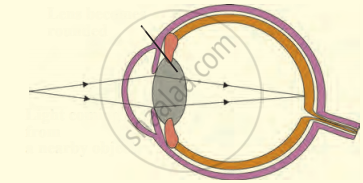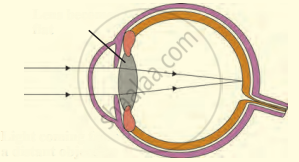Advertisements
Advertisements
प्रश्न
The following figure show the change in the shape of the lens while seeing distant and nearby objects. Complete the figures by correctly labelling the diagram.

उत्तर
Light coming from a nearby object-

APPEARS IN
संबंधित प्रश्न
Write the function of the following part of the human eye:- iris
Write the function of the following part of the human eye: ciliary muscles
Draw a labelled sketch of the human eye.
With the help of ciliary muscles the human eye can change its curvature and thus alter the focal length of its lens. State the changes that occur in the curvature and focal length of the eye lens while viewing (a) a distance object, (b) nearby objects.
Explain why the image distance in the eye does not change when we change the distance of an object from the eye?
A person got his eyes tested by an optician. The prescription for the spectacle lenses to be made reads :
Left eye : +2.50 D
Right eye : +2.00 D
Which lens bends the light rays more strongly?
Where does the greatest degree of refraction of light occur in the eye?
What is the least distance of distinct vision for a normal human eye?
Define the term "power of accommodation" of human eye.
Give the scientific names of the following parts of the eye:
changes shape to focus a picture on the retina.
Refraction of light in the eye occurs at:
(a) the lens only
(b) the cornea only
(c) both the cornea and the lens
(d) the pupil
When is a person said to have developed cataract in his eye? How is the vision of a person having cataract restored?
State whether the following statement is true or false:
Rabbit has eyes which look sideways.
The animal which does not have eyes that look sideways is:
(a) Horse
(b) Chicken
(c) Lion
(d) Fish
Having two eyes gives a person:
(a) deeper field of view
(b) coloured field of view
(c) rear field of view
(d) wider field of view
With reference to the functioning of the eye, answer the question that follow:
Name the cells of the retina and its respective pigments which get activated in the dark.
Choose the correct answer.
Colour is detected by ____________
Differentiate between:
Yellow spot and Blind spot.
Name the following:
The most sensitive region of the retina.
Give Technical Term:
The adjustment of the eye in order to obtain a clear vision of objects at different distances
Give Technical Term:
The nutritive layer of the eye which also presents reflection of light.
Mention, if the following statement is True or False
Cones are the receptor cells in the retina of the eye sensitive to dim light.
State the Function:
Visual purple
State the Function:
Vitreous humour
Write the name.
The screen with light sensitive cells in human eye.
The following figure show the change in the shape of the lens while seeing distant and nearby objects. Complete the figures by correctly labelling the diagram.

Shylesh is a school-going kid studying standard VIII. He is crazy about playing video games on mobile phones. After a couple of months, his eyes turned red and he felt severe pain in his eyes. His science teacher enquired about this and advised his parents to take him to an eye doctor.
- How does excessive usage of mobile phone affect our eyes?
- What are the values shown by the teacher?
The pigmented circular area seen in front of the eye:
Boojho while waving his hand very fast in front of his eyes, observes that his fingers appear blurred. What could be the reason for it?
Write down the names of parts of the eye in the blank spaces shown in the figure.

Match the following:
| Column - I | Column - II | ||
| 1 | Retina | a | Path way of light |
| 2 | Pupil | b | Far point comes closer |
| 3 | Ciliary muscles | c | near point moves away |
| 4 | Myopia | d | Screen of the eye |
| 5 | Hypermetropoia | e | Power of accomodation |
Match the following:
|
Column - I |
Column - II | ||
| 1 | Retina | a | Path way of light |
| 2 | Pupil | b |
far point comes closer |
| 3 | Ciliary muscles | c |
near point moves away |
| 4 | Myopia | d | Screen of the eye |
| 5 | Hypermetropia | e | Power of accommodation |
Match the following.
| Column - I | Column - II | ||
| 1 | Retina | a | Path way of light |
| 2 | Pupil | b | Far point comes closer |
| 3 | Ciliary muscles | c | near point moves away |
| 4 | Myopia | d | screen of the eye |
| 5 | Hypermetropia | e | Power of accomadation |
State the functions of the following:
Iris
Name the following:
Kind of retinal cells sensitive to dim light.
The layer in the eye where sensory cells (rods and cones) are located ______.
With reference to human eye answer the question that follow:
Name the part of the eye associated with the regulation of the size of pupil.
With reference to human eye answer the question that follow:
Name the part of the eye associated with the regulation of the shape of lens.
